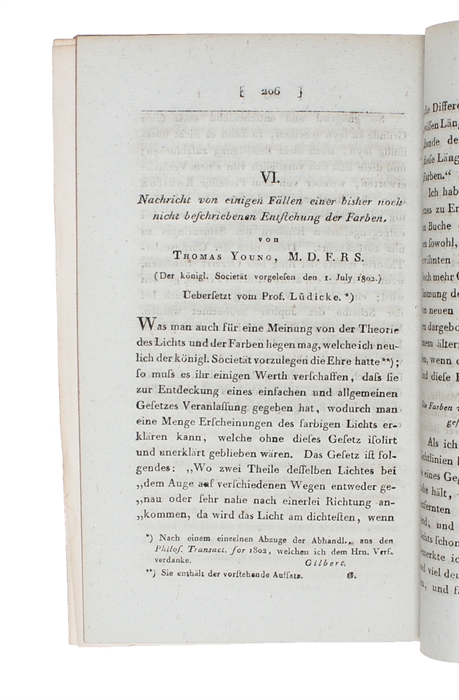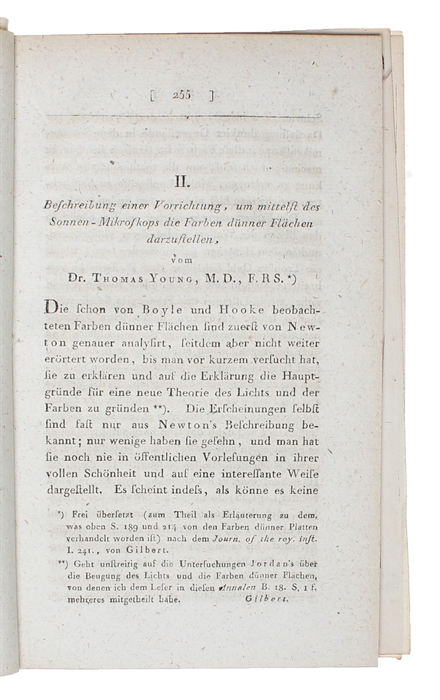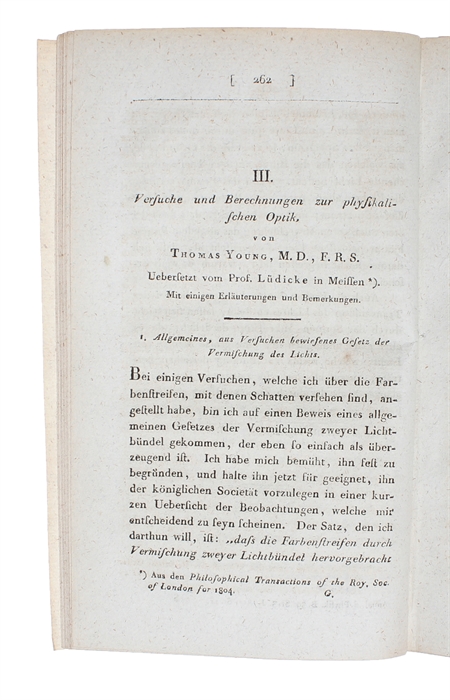YOUNG, THOMAS. - THE DISCOVERIES OF THE INTERFERENCE OF LIGHT - GERMAN EDITIONS.
Ueber die Theorie des Lichts. Frei übersetzt vom Professor Lüdicke. (+) Nachricht von einigen Fällen einer bisher noch nicht beschriebenen Entstehung der Farben. (+) Beschreibung einer Vorrichtung, um mittelst des Sonnen-Mikroskops die Farben dünner Fläcken darzustellen. (+) Versuche und Berechnungen zur physikalischen Optik. (4 Papers).
Leipzig, Johann Ambrosius Barth, 1811. Without wrappers. In: "Annalen der Physik. Hrsg. Ludwig Wilhelm Gilbert", Bd. 39 (der Reihe), Eilftes u. Zwölftes Stück. Titlepage to vol. 39. Pp. 129-244 a. 2 engraved plates. (The entire issue offered). Young's papers: pp. 156-205 a. pp. 206-220. And pp. 245-360 a. 2 engraved plates. (The entire issue offered). Young's papers: pp. 255-261 a. pp. 262-290.
First appearance in German of Youngs 3 groundbreaking papers ( On the Theory of Light and Colours 1802 - An account of some Cases of the Production of Colours not hitherto described 1802 - The Bakerian Lecture. Experiments and Calculations relative to physical Optics. 1804) - which gives the first really convincing evidence that the fringes are produced by interference of light waves, and giving the experimental demonstrations of the general law of Interference.These importent demonstrations served as the experimental basis for the wave hypothesis of light. - In his two first papers "On the Theory of Light and Colours", 1802 and "An account of Some Cases of the Production of Colours not hitherto described", 1802 - he only partially announced his principle of Interference, and the statement of it in "An Account..." was entirely hypothetical and not experimental. (Magie. Source Book in Physics gives extracts of this paper and a later paper under the head: Discovery of the interference of light, pp.308-15).
Young also shows here that diffraction effects can be explained by the interference law.
"The experimental basis for the wave hypothesis of light as Young formulated it was interference. The fact has already been observed that two trauins of water waves may be so superposed that in certain regions the throughs of one train will lie continuously on the crests of another, thereby producing zero disturbance...Destryctive interference is said to occur between the two trains of waves in the former case and constructivee interference in lthe latter. Similarly, two sound waves may be so combined as to produce alternate regions of silence and enhanced sound. The phenomenon of interference, of which the forgoing are familiar examples, is easely comprehensible in the case of combining waves, but would be utterly incomprehensible in the case of combining streams of particles. So when Young demonstrated that two beams of light could, under properly controlled conditions be made to combine in such a way as to produce alternate regions of darkness and light, he was rightly considered to have identified in light a characteristic property of waves." (Lloyd Taylor in: Physics. The Pioneer Science. p. 511).
Of the three papers published in the years 1802-04 the last is the most importent as it gives the experimental demonstrations of the interference of light. (Dibner in Heralds of Science No. 151 list the first paper, so does PMM: 259).
Order-nr.: 44092





